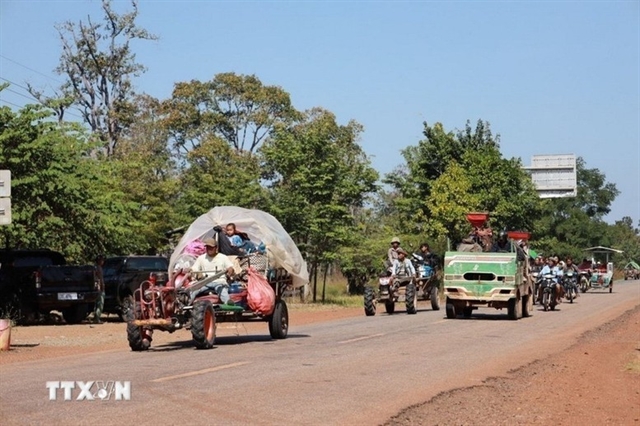 Sunday/Weekend
Sunday/Weekend

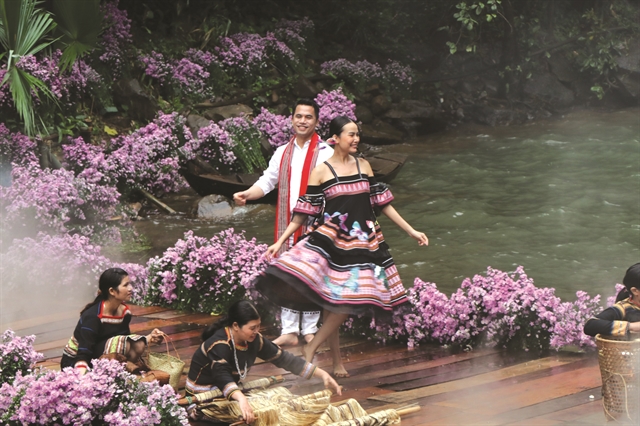 |
| CENTRAL HIGHLANDS FASHION: People from ethnic groups in Kon Tum and 40 professional models and artists showcase dresses and 'áo dài' made of handloom fabric from 11 Vietnamese designers in a fashion show held at the Pa Vỹ Waterfall Eco-tourism Area in Kon Plông District on October 29. VNA/VNS Photo by Khoa Chương |
The Tây Nguyên (Central Highlands) province of Kon Tum has launched a series of activities highlighting the cultural heritage preservation of ethnic minorities in the region as a way to boost tourism.
More than 54 per cent of the province's population of 540,000 is made up of ethnic minorities, including the Xê Đăng, Bahnar, Jrai, Bahnar, Gié-triêng, Rơ Măm, Brâu, and Hre.
Kon Tum authorities recognise the province's diverse cultures, and acknowledge the importance of cultural heritage to the community and socio-economic development.
The Department of Culture, Sports and Tourism has worked with relevant agencies and authorities to launch a wide range of activities promoting ethnic minority heritages such as gong culture, handloom weaving, festivals, social customs, and architecture.
Kon Tum recently hosted a fashion show of áo dài (Vietnamese traditional dress) made of colourful ethnic cloth to highlight the ancient weaving craft.
The fabric used in the show was made by artisan Y Thoại. It has the signature colours of black, yellow and red, along with the signature patterns of birds, gongs and elephant tusks.
The show was held late last month at the Pa Vỹ Waterfall Eco-tourism Area in Kon Plông District, one of the province’s must-visit destinations.
The presentation featured more than 200 designs created by 11 Vietnamese fashion designers such as Cao Minh Tiến, Công Huân, Nguyễn Thúy, and Minh Hạnh.
“Each brocade áo dài is a unique item conveying the ethnic culture of minority groups in Tây Nguyên such as the Ê Đê, the Bahnar, and the Xê Đăng, who create different patterns and colour combinations for brocade,” said veteran designer Minh Hạnh.
Hạnh is globally known for pioneering designs honouring the beauty of artisanal fabric made by ethnic groups in the Northwestern and Central Highlands regions.
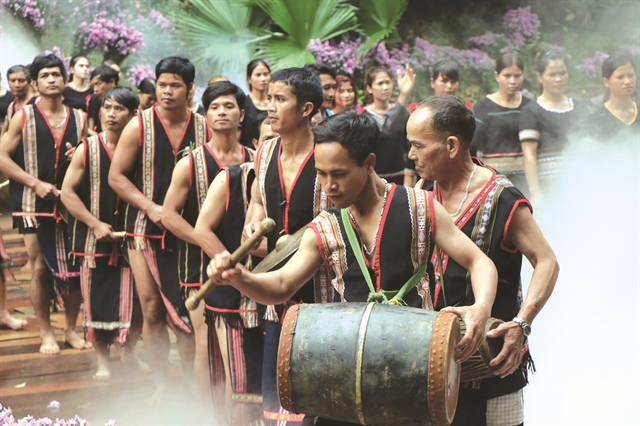 |
| MUSIC AND DANCE: Ethic musicians perform traditional music and dances at the fashion show. VNA/VNS Photo by Khoa Chương |
More than 100 young people from the province’s various ethnic groups and 40 professional models and artists showcased designs at the show.
Ethnic musicians also offered traditional music and dance performances at the event.
Đặng Quang Hà, chairman of the Kon Plông District’s People’s Committee, said: “It’s the first time leading Vietnamese designers have presented áo dài made of ethnic cloth in the province. The event contributes to preserving and promoting ethnic cultural values among tourists.”
Another event honouring gong culture in the Central Highlands was also held in the city of Kon Tum in September.
The festival created an opportunity for artisans to meet and to share ethnic cultural heritage with the community in order to raise awareness of protecting and preserving the gong culture.
Gong culture was recognised as a Masterpiece of the Intangible Heritage of Humanity by UNESCO in 2005.
More than 600 artisans, musicians and performers in traditional costumes across the province participated in the event to introduce the traditional cultural traits of the region to local and international visitors.
They performed their gong dances and folk music with folk musical instruments from different ethnic groups.
Nguyễn Văn Bình, director of the province’s Department of Culture, Sports and Tourism, said the tourism sector was seeking to create new tourism products carrying the cultural identity of the Central Highlands to attract local visitors to the province.
Tourism development
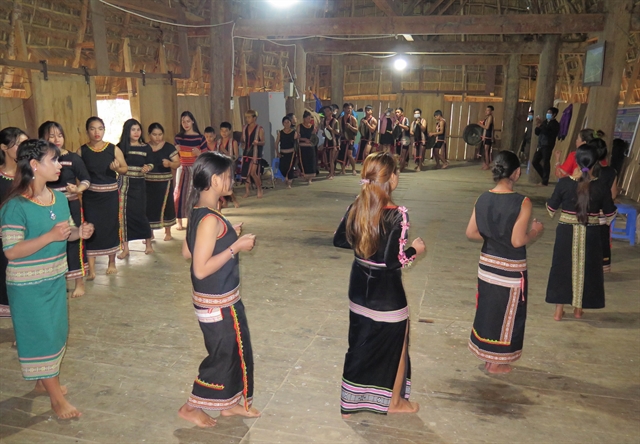 |
| DANCE PARTY: Visitors perform dancing with local people at a community-based tourism village in Kon Tum. VNA/VNS Photo by Dư Toán |
In May, Kon Tum authorities announced its tourism development plan to 2025 that considers developing community-based tourism as one of the key tasks of the tourism sector.
There are dozens of community-based tourism villages where tourists can enjoy beautiful natural landscapes and learn about the culture and lifestyle of different ethnic groups.
Popular villages, such as Kon Kơ Tu in Kon Tum City and Đăk Răng in Ngọc Hồi District, offer visitors ethnic food, gong dance performances, handloom fabric products, and tours to discover the history and folk tales of the Central Highlands told by elderly locals.
According to artisan Y Lim of Kon Pring Village, more than 1,000 tourists arrived at the village this year. Tourism activities brought her family VNĐ15–20 million (US$600-800) per month, helping them not only to have a stable income but also to be able to promote their cultural values.
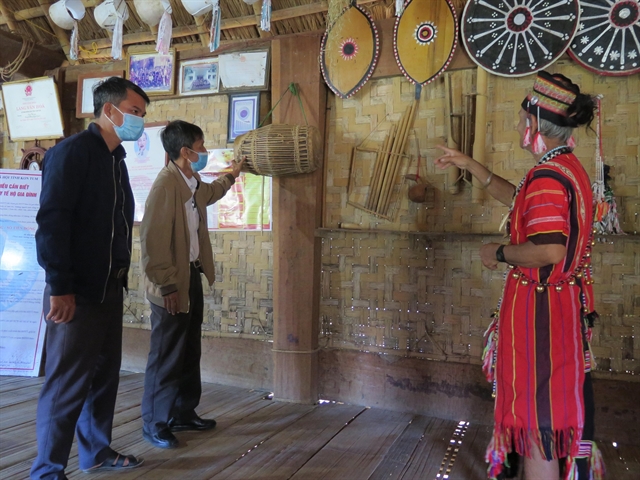 |
| ORAL HISTORY: Tourists learn about the history and culture of ethnic minority groups in Kon Tum through tales of an elderly villager. VNA/VNS Photo by Dư Toán |
Bình said: “Kon Tum and its people are working together to preserve cultural heritage for tourism development and contribute to improving ethnic groups’ living standards and socio-economic development, in general.”
He added the province currently was focusing on the domestic market with the aim of reviving its tourism industry.
In April, the province signed a cooperation agreement on tourism development with the Central provinces of Phú Yên, Bình Định and Quảng Ngãi, and the Central Highlands provinces of Đắk Lắk and Gia Lai.
Its Department of Culture, Sports and Tourism is working with the tourism associations of Hà Nội, Đà Nẵng and HCM City to support the province to create new and unique tourism products to attract more visitors.
 |
| WEAVING SKILL: Local women at the Kon Trang Long Loi community-based tourism village in Đắk Hà District weave fabric with handlooms. VNA/VNS Photo by Dư Toán |
Speaking at the forum on tourism development in Kon Tum in April, Hà Văn Siêu, deputy director of the Việt Nam National Administration of Tourism, said that Kon Tum had potential to become a new tourism spot after the COVID-19 pandemic.
However, challenges such as lack of accommodation, human resources, and transport connections with neighbouring provinces prevented Kon Tum from development, he added.
Kon Tum is calling on investment in luxurious accommodations, human resources, and transportation infrastructure to connect tourism sites and destinations among the provinces in the Central Highlands to help the province complete its tourism plan.
Under the plan, the province targets to have at least five hotels with four or five-star standards and recruit 3,000 tourism workers by 2025.
It also expects to welcome 2.5 million visitors by 2025.
More than 982,000 tourists have so far this year visited Kon Tum, reaching 109 per cent of the year’s target. — VNS



